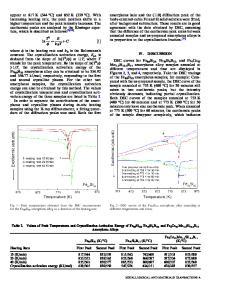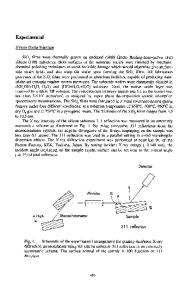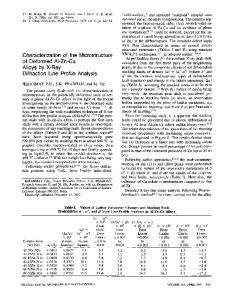Lattice imperfections studied by x-ray diffraction in deformed aluminum-base alloys: Al-Ge alloy
- PDF / 180,857 Bytes
- 2 Pages / 594 x 774 pts Page_size
- 56 Downloads / 341 Views
compound fault probability (4.5a" +/3) was found to be appreciably low, indicating a negligible presence of deformation twin and extrinsic faulting (Table I). Using Stokes' corrected Fourier coefficients Ac (Figure 3), the detailed Fourier analysis has been performed, and the values of effective domain size De, root-mean-square strain (e2) '/2, and compound fault probability 1.5(a' + a") +/3 were calculated in the usual manner using relevant equations, [3,4'5J and the values are shown in Table I. The De values appear to be quite high, indicating small and negligible concentrations of deformation faults and a slightly smaller value of De at the highest concentration; i.e., 4.60 at. pct Ge may be an indication of a slight tendency of the formation of stacking fault density. However, the negligibly small values of [1.5(a' + a") + /3], the compound fault probability (Table I), compared to other Ag- or Cu-base alloys[3-7] show that this aluminum-base alloy, in general, is not prone to faulting. Combining the results of three analyses, such as line shift, line asymmetry, and line shape, the values of deformation stacking fault densities, like intrinsic a', ex-. trinsic a", and twin fault/3 were calculated; these values are shown in Table I. It appears from these values that the tendency of faulting (both deformation and twin) in this alloy system, even after extensive cold working, is very small, as the values of a' and a" remain negative until 4.16 at. pct Ge and the values of/3 remain negative in all concentrations. The stacking fault energy parameter 7//x, where/x is the shear modulus, and dislocation density p were calculated using relevant equations used in earlier w o r k s . [3,4] The values of p, for all alloy compositions, were found to be quite high (from 1.2 x 10Hto 0.96 x 10H cm/ cm3). The stacking fault energy parameter 7//x was found to vary from 4.4 • 10 -H to 0.47 • 10 -H between 3.10 and 4.60 at. pct Ge. From all of these observations, it may be concluded that this A1-Ge alloy system is not prone to faulting, even after extensive cold working, and a slight indication of the precipitation of faulting may only be obtained from the higher concentration of Ge, i.e., 4.16 at. pct. Though no X-ray diffraction work on this AI-Ge system is reported, the main observation obtained in this analysis, that is, high stacking fault energy compared to other metals and alloys, is compatible with the high stacking fault
At % GQ ~ 700
I0 I
600~
20 i
~
50 i
50 60 70 80 90 ,/ I I I
40 ,
LIQUID
//
//// I
I
! 4!
4 O0
,,
)
I
55
J.
I
30
O0 -
I
I
IO
20
I 30
I 40
I
I
I
I
a
50
60
70
80
90
I00
Wt % Ge Fig. 1 - - P h a s e diagram of the A1-Ge system. VOLUME 21A, SEPTEMBER 1990--2597
Table I. The Values of Effective Domain Sizes (D,), Root-Mean-Square Strain (e2) ~/2, Compound Fault Probabilities (a' - a"), [4.5(a") + fl], and [1.5(a' + a") + ~], and Individual Values of a', a", and fl (4.5a" + /3) • 104 X 103 From Line F r o m Line Asymmetry Shift Analysis Analysis (Error Limit: (Error Limit
Data Loading...











